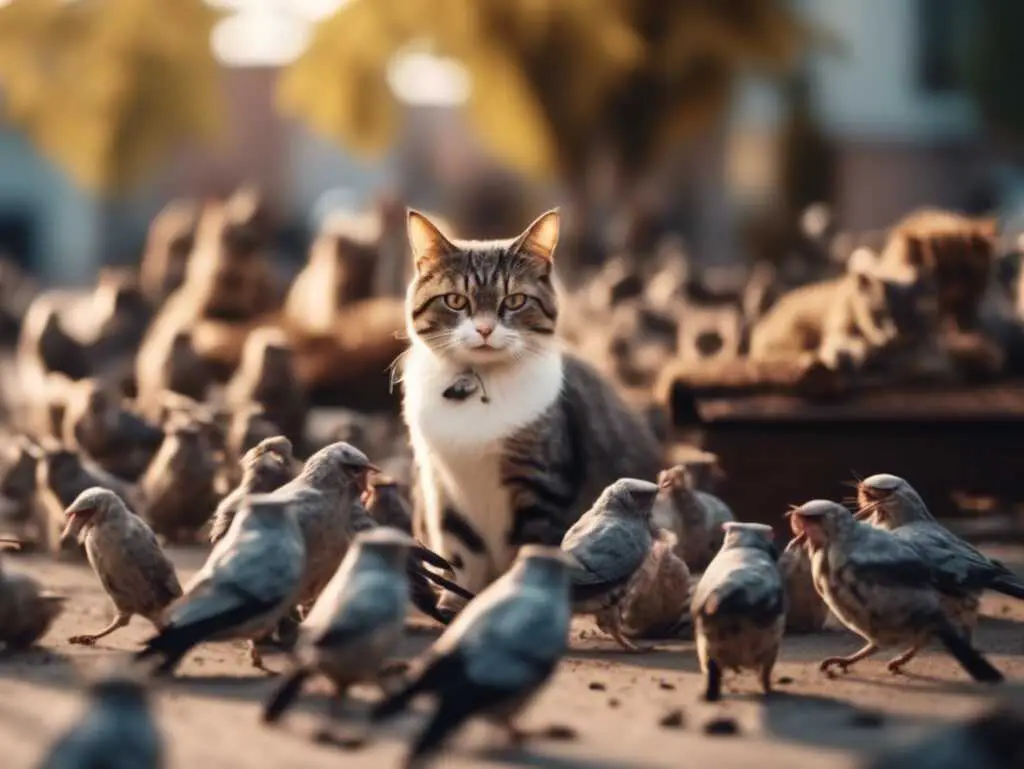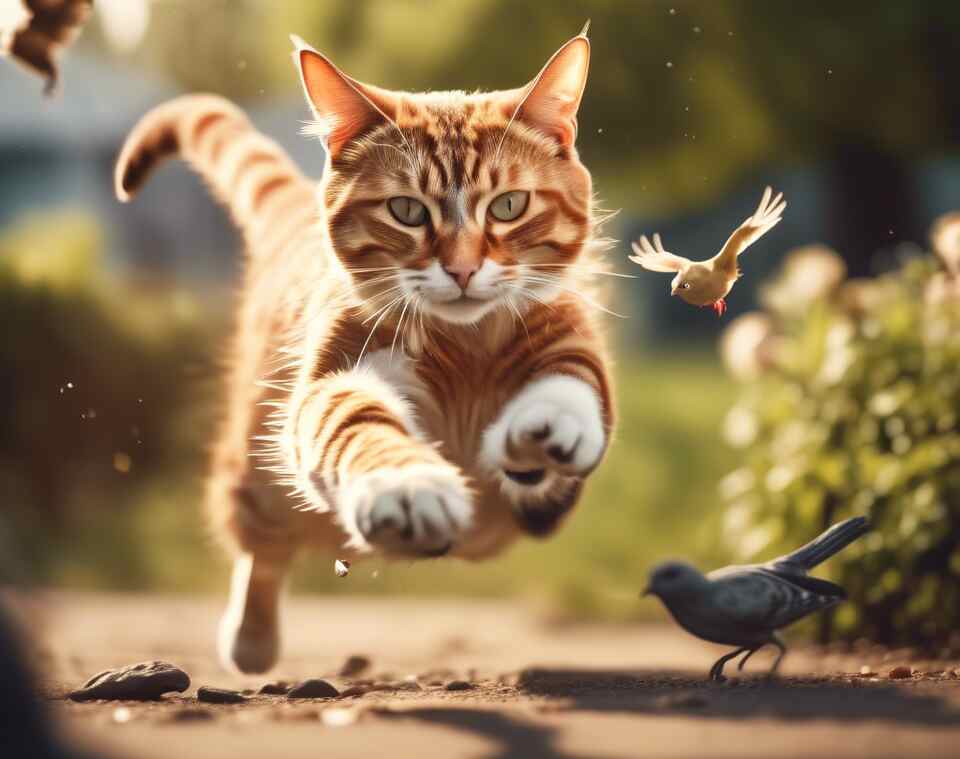Cats are beloved pets in many households across North America, but their presence also poses a significant threat to the bird populations in the region. The impact of domestic cats on bird populations has been a subject of concern among researchers and conservationists for years. Understanding the extent of this impact is crucial for implementing effective measures to protect vulnerable bird species.
Table of Contents
The Impact of Domestic Cats on Bird Populations in North America
The Predatory Nature of Cats
Cats are natural hunters with strong predatory instincts. Even well-fed domestic cats retain their hunting behavior, which makes them a formidable threat to bird populations. The stealth and agility of cats enable them to catch birds with relative ease, leading to considerable bird mortality rates.
Estimating Bird Mortality Caused by Cats
Research studies have attempted to estimate the number of birds killed by domestic cats in North America. The findings suggest that the impact is substantial, with one study indicating that domestic cats in the United States alone kill approximately 2.4 billion birds annually. This staggering number underscores the significant effect that cats have on bird populations across the continent.
The scale of this predation is attributed to the large number of domestic cats, including both owned pets allowed outdoors and unowned feral cats. Even well-fed cats exhibit hunting behaviors, and their mere presence can negatively affect bird populations by disrupting nesting and breeding patterns.
These estimates have raised concerns among conservationists and ornithologists about the long-term effects on bird biodiversity. While birds reproduce annually, helping to offset some of the losses, there are worries that this level of predation may not be sustainable in the long run, especially for species already facing other threats such as habitat loss.
It’s important to note that domestic cats are not native to North American ecosystems, and their impact extends beyond birds to other wildlife as well. This situation presents a complex challenge, balancing the welfare of domestic cats with the conservation of native wildlife species.
Impact on Vulnerable Bird Species
Certain bird species are more vulnerable to cat predation than others. Ground-nesting birds, fledglings, and birds that are not adept at evading predators are particularly at risk. Cats can significantly impact the populations of these vulnerable bird species, which can have cascading effects on the ecosystem as a whole.
Conservation Efforts and Responsible Pet Ownership
Conservationists emphasize the importance of responsible pet ownership in mitigating the impact of cats on bird populations. Keeping cats indoors, especially during peak bird migration periods, can significantly reduce bird mortality. Providing cats with alternative forms of enrichment and stimulation can also help curb their hunting instincts.
Collaborative Solutions
Addressing the issue of cat predation on birds requires a collaborative effort between pet owners, conservation organizations, and policymakers. Implementing programs such as Trap-Neuter-Return (TNR) for feral cat populations can help control their numbers and reduce their impact on bird populations. Education campaigns aimed at raising awareness about the issue can also play a vital role in fostering a more harmonious relationship between cats and birds.
The impact of domestic cats on bird populations in North America is a complex and multifaceted issue that requires careful attention and proactive solutions. By understanding the predatory nature of cats, estimating bird mortality rates, focusing on vulnerable bird species, promoting responsible pet ownership, and implementing collaborative conservation efforts, we can strive towards a more sustainable coexistence between cats and birds in the region.
Ultimately, striking a balance between the well-being of both domestic cats and native bird species is essential for maintaining the ecological equilibrium in North America.
Strategies to Reduce Bird Mortality Caused by Cats
Understanding the Issue
The impact of domestic cats on bird populations in North America is a significant concern for conservationists. Studies suggest that cats kill billions of birds each year in the United States alone. This predation by cats poses a serious threat to various bird species, including songbirds and other small mammals. As responsible pet owners and environmental stewards, it is crucial to address this issue and implement strategies to reduce bird mortality caused by cats.
Implementing Responsible Pet Ownership Practices
One effective strategy to mitigate bird mortality caused by cats is to promote responsible pet ownership practices. Pet owners can take simple steps to minimize their cat’s impact on local bird populations. Keeping cats indoors, especially during peak bird activity times such as dawn and dusk, can significantly reduce the chances of cats preying on birds. Additionally, ensuring that cats are well-fed and stimulated with toys and other enrichment activities can help curb their hunting instincts.
Utilizing Cat Enclosures and Outdoor Enclosures
Cat enclosures, also known as “catios,” provide a safe outdoor space where cats can enjoy the sights and sounds of the outdoors without posing a threat to birds and other wildlife. These enclosures can be attached to windows, balconies, or patios and come in various sizes and designs to suit different living situations. By allowing cats to experience the outdoors within a contained environment, cat enclosures help protect local bird populations while still offering enrichment for feline companions.
Supporting Trap-Neuter-Return Programs for Feral Cats
Feral cat populations can have a significant impact on local bird populations due to their hunting behavior. Trap-Neuter-Return (TNR) programs aim to humanely manage feral cat colonies by trapping cats, spaying or neutering them, and then returning them to their original location. By addressing the root cause of overpopulation and reducing the number of feral cats in the wild, TNR programs can help lessen the impact of cats on bird mortality.
Spreading Awareness and Education
Education plays a vital role in raising awareness about the impact of cats on bird populations. By sharing information about the risks posed by outdoor cats to birds and other wildlife, communities can work together to find humane and effective solutions. Public outreach campaigns, workshops, and educational materials can help pet owners understand the importance of keeping cats indoors and implementing measures to protect local wildlife.
Collaborating with Local Conservation Organizations
Collaborating with local conservation organizations and bird advocacy groups can amplify efforts to reduce bird mortality caused by cats. By partnering with experts in wildlife conservation, pet owners can access resources, guidance, and support to create cat-friendly communities that prioritize the well-being of both feline companions and local bird populations.
Addressing bird mortality caused by cats requires a multifaceted approach that combines responsible pet ownership practices, the use of cat enclosures, support for TNR programs, education and awareness initiatives, and collaboration with conservation organizations. By working together to implement these strategies, we can protect our feathered friends and create a safer environment for birds to thrive alongside our feline companions.
Conclusion
In North America, the impact of domestic cats on bird populations is undeniable. With millions of birds falling victim to cat predation each year, it is crucial to implement strategies that will help reduce bird mortality and protect these avian species. By understanding the predatory behavior of cats and taking proactive measures to mitigate their impact, we can work towards creating a more harmonious environment where both cats and birds can thrive.
One of the key strategies to reduce bird mortality caused by cats is promoting responsible pet ownership. Cat owners play a vital role in ensuring that their feline companions do not pose a threat to local bird populations. By keeping cats indoors or supervised when outdoors, owners can significantly decrease the risk of cats preying on birds. Additionally, spaying and neutering cats can help reduce their urge to hunt, further protecting bird species from unnecessary harm.
In addition to responsible pet ownership, another effective strategy is the implementation of bird-friendly landscaping practices. Creating bird-friendly environments that include dense shrubbery and trees can provide birds with safe spaces to seek refuge from predators like cats. By planting native vegetation and avoiding the use of pesticides, homeowners can attract a variety of bird species while minimizing the risk of cat predation.
Furthermore, raising awareness about the impact of domestic cats on bird populations is essential in fostering a sense of responsibility among communities. Education campaigns that highlight the importance of protecting birds and the detrimental effects of cat predation can encourage individuals to take proactive steps in safeguarding local bird species. By promoting coexistence between cats and birds, communities can work together to create a more sustainable environment for both animals.
Moreover, the development and implementation of bird-safe practices in urban and suburban areas are critical in reducing bird mortality caused by cats. Encouraging the use of bird-friendly building designs, such as incorporating window screens and installing cat deterrents in outdoor spaces, can help minimize fatal encounters between cats and birds. Collaborating with local authorities and wildlife organizations to enact regulations that promote bird conservation can also contribute to mitigating the impact of cat predation on bird populations.
The protection of bird populations in North America requires a collective effort from cat owners, community members, and policymakers. By adopting responsible pet ownership practices, creating bird-friendly environments, raising awareness about the impact of cat predation, and implementing bird-safe measures, we can work towards reducing bird mortality and preserving the beauty and diversity of avian species in our local ecosystems. Through concerted actions and a shared commitment to coexistence, we can strive to ensure a brighter future for both cats and birds in North America.



